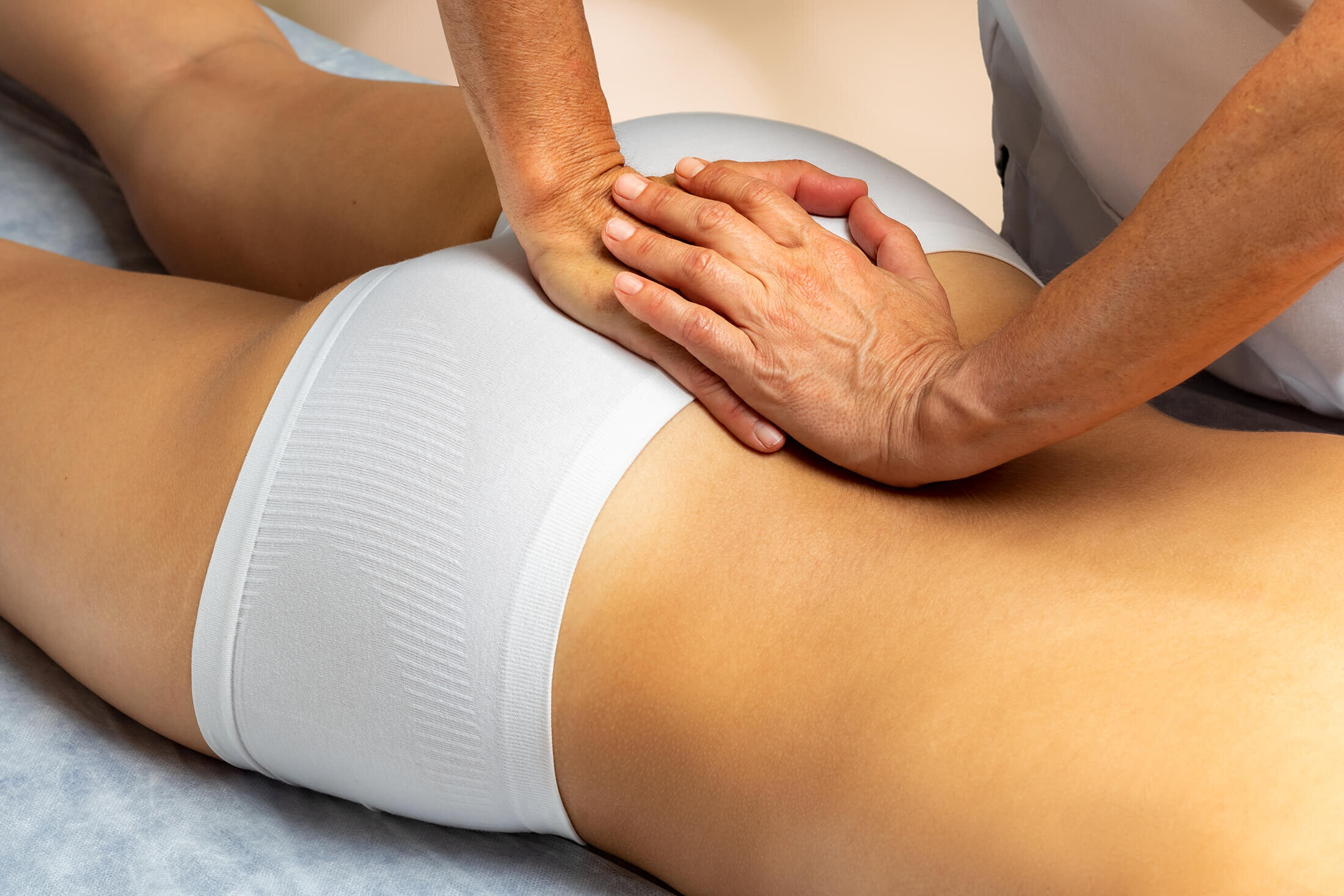
Tailbone / Bladder / Painful Periods
Tailbone
Falling on your tailbone (coccyx) or your sit-bones is akin to a vertical whiplash causing a chain reaction of compactions. The tailbone compacts with the sacrum, the sacrum with the lower back vertebrae, and the effects can even travel to your upper neck and brain. The mechanisms of a car accident can also have an element of a vertical whiplash causing tailbone pain.
Tailbone Pain Treatment
Tailbone pain treatment at the Vancouver Osteopathy Centre begins with an assessment of pelvic relationships as in the diagram above. Falling on your tailbone can cause it to curl under, or twist to the left. This in turn alters the relationship between your tailbone and your hip joints. Superimpose this relationship on top of the relationship between the sacroiliacs (SI joints) and the pubic bone at the front of the pelvis, and your whole pelvic ring can endure a painful twist.
Tailbone Pain Treatment The Osteopathic Way:
Soft tissue techniques help release tension in your pelvic floor muscles and harmonize the movement of all 3 diaphragms in the pelvis, ribcage and head. We assess your tailbone and pelvic joints’ alignment. External techniques are mostly used but internal work is sometimes required and performed by a practitioner licensed to do so. (see: OMT)
- What sets Osteopathic Practitioners apart is our ability to address the nuances of your nervous system. Even though your spinal cord ends in the upper lumbar spine, the envelope that surrounds it has an important attachment to your tailbone. Tailbone pain treatment is not complete without assessing your cranial base and the iliac bones of your pelvis. (See: Craniosacral Therapy)
Client Testimonial
“ I suffered from chronic prostatitis for 6 months and my urologist prescribed antibiotics which I took repeatedly for the 6 months. My practitioner at the Vancouver Osteopathy Centre suggested we look at my pelvic floor. Who would have thought my chronic prostatitis pain was just tension in my pelvic floor? She released the nerves that go from my spinal cord to my tailbone and that relieved my chronic back pain too”.
-Roland M.
Bladder Treatment
Bladder treatment is sought by both men and women with symptoms ranging from:
urgency
frequency
incontinence
chronic infections
pain.
Many women accept that bladder leakage is normal and may not know that bladder treatment is available. It is very common affecting 1 in 4 women, but normal it is not. Bladder issues can arise from a prolapse downwards of one or more of your pelvic organs. A cystocele occurs when your bladder bulges into the front of your vagina, and a rectocele when the rectum bulges into the back of your vagina.
Bladder Treatment The Osteopathic Way:
Research has shown that visceral techniques addressing bladder position and mobility with the uterus can help with incontinence. (see: Visceral Manipulation)
Urgency, dribbling and frequency can be treated successfully with careful attention to L1, L2 and the sacrum. The nerves supplying your bladder come from these levels of the lumbar spine and the sacrum. Fascial techniques release tension in the pelvic floor and help synchronize its’ movement with that of the thoracic breathing diaphragm. This helps harmonize pressure systems in your body which is crucial in bladder treatment. A rounded posture can negatively impact bladder control as it increases intra-abdominal pressure. Pelvic floor exercises, an important part of bladder treatment, prove infinitely more successful when performed with a well-aligned and pressure-balanced system. (see: OMT)
Client Testimonial
“ I was referred to the Vancouver Osteopathy Centre for pelvic floor pain, grade 2 uterine prolapse and stress incontinence. My practitioner was very compassionate and knowledgeable and took time to explain things to me. I experienced significant pain relief…”
-Ivy C.
Painful Periods:
Do you experience painful periods? Or symptoms of:
mild discomfort to severe period cramps
pain in the abdomen, pelvic floor, lower back, hips and legs
digestive woes
In the case of endometriosis, the tissue lining the inside of your womb can grow outside. This causes adhesions and scarring affecting your ovaries, fallopian tubes, the tissues lining your pelvis as well as your intestines. Clients seeking period cramps treatment often report digestive distress with bloating.
Period Cramps Treatment The Osteopathic Way:
Soft tissue and visceral techniques in the pelvis and abdomen can loosen adhesions and offer great relief. (see: Visceral Manipulation)
We pay attention to the alignment of your pelvis and the lumbar vertebrae from where the nerves emerge that supply your uterus and intestines. (see: OMT)
We release mechanical tensions that could impede optimal functioning of the pituitary gland affecting your hormonal system. (see: Craniosacral Therapy)
While most techniques are performed on the exterior of the body, there are cases when a more successful outcome may be achieved by performing techniques internally on the tailbone, bladder and pelvic floor. Clients can freely choose how they wish their treatment to proceed. Internal techniques are performed by a practitioner licensed to do so.
“I was suffering from endometriosis and osteopathy was instrumental in my recovery process. The treatments addressed the endometrial adhesions I had on my organs as they are inherently fascia and scar tissue. Surgery is the only way to cut out the endometrial tissue but there is a place for hands- on manual therapy to help ease the pull this fascia has on your abdominal cavity and the general discomfort it causes.”
- Nicole R.









